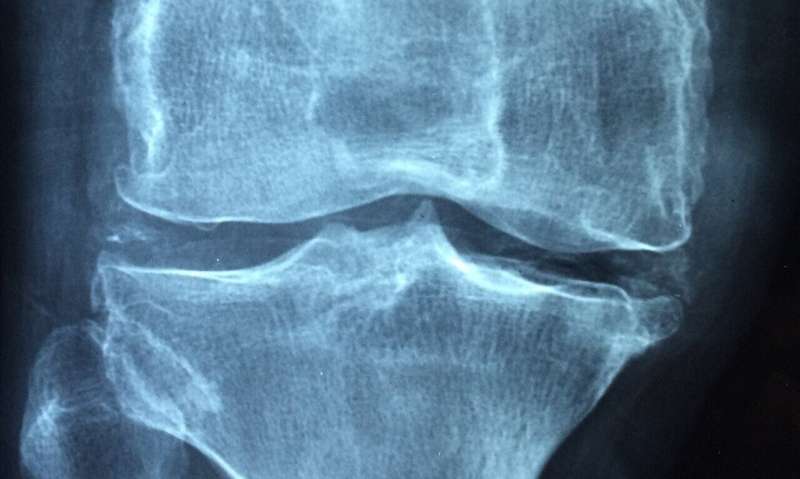, 2025-04-18 15:57:00

Even after surgery, injuries to the anterior cruciate ligament (ACL) often lead to chronic pain and reduced mobility, with limited options for treatment. New research suggests that advances in knowledge and therapeutics may come from an unlikely source: dogs.
In a study published April 18 in the Journal of Orthopedic Research, Cornell researchers found that the same protein accumulates in the joints of both dogs and humans after ACL injury. That means using dogs as a model to study ACL injury—and the post-traumatic osteoarthritis (PTOA) that often follows—may vastly accelerate advances in understanding.
“Our study provides support for using naturally occurring disease in dogs to learn more about human medicine,” said Sydney Womack, first author and a dual DVM and Ph.D. candidate in the College of Veterinary Medicine (CVM). “Dogs live with us in our houses, they eat off of our plates, they go on runs and hikes with us—they’re probably as close as we can get to mimicking human lifestyle, and I think they’re a huge untapped resource.”
ACL injuries are common in young athletes, disproportionately affecting females, and can lead to the development of PTOA relatively early in life, but why some people develop the condition sooner or later after injury, at different levels of severity, remains a mystery. Current treatments can help alleviate symptoms but can’t stop the disease from developing or progressing.
The upregulated protein shared between the two species—called periostin—had been documented in the joint fluid of humans after ACL injuries but not in dogs.
“It’s rare to repeat a result like that in the same species, let alone two,” said Heidi Reesink, senior author and associate professor of clinical sciences (CVM), with a joint appointment at the University of California, Davis. “It’s exciting because we followed the same methodology for both species—you might find a study that just looks at humans or just looks at dogs, but there’s always going to be variation between labs and how samples were processed that makes it hard to compare between studies. That’s not the case here.”
The researchers used joint fluid samples from canine patients at the Cornell University Hospital for Animals, which were stored by the Cornell Veterinary Biobank, and samples from human patients at the Hospital for Special Surgery (HSS) in New York City. The team analyzed all the proteins in the samples and found that 60% of proteins detected were shared between the species, with periostin being by far the most upregulated in both dogs and humans.
“There are many potential targets and a lot of overlap between dogs and humans,” Reesink said. “This study is powerful because it suggests that dogs could be valuable for answering questions that are harder to study in people, all while we find better treatments for both species.”
Dogs’ shorter life expectancy, as well as easier access to joint fluid samples, could expedite the study of PTOA’s progression and its treatments.
“With dogs, we’ll be able to study the progression of the disease within 10 years,” Womack said, “whereas humans live so much longer, and it’s much harder to get healthy knee tissue samples to use as controls.”
Womack is already looking more closely at the role of periostin and its potential as a therapeutic target or biomarker, which may indicate a person’s risk of developing PTOA.
“There’s some evidence that periostin is really important in the immediate wound-healing stage, but then chronic upregulation of periostin could lead to increased inflammation and degeneration of the joint,” Womack said. “I’m studying periostin in mice right now, and I’m excited to see if decreasing or removing periostin expression changes the disease progression.”
Reesink said the upregulation of periostin is also implicated in heart disease and certain cancers in humans, so studying it as a therapeutic target, in dogs or other animal models, could have implications for a wide range of diseases.
“We have an interest in understanding its role in other types of joint disease, including age-related arthritis and other types of traumatic injury,” Reesink said. “There could be shared therapeutics developed that target these signal pathways and improve a whole host of conditions across species.”
Co-authors of the study include Camila B. Carballo, assistant professor of musculoskeletal research in orthopedic surgery at Weill Cornell Medical College; Scott A. Rodeo, professor of orthopedic surgery at Weill Cornell Medicine, with a joint appointment at HSS; and doctoral candidate Erica J. Secor ’09, DVM ’13.
More information:
Sydney J. Womack et al, Proteomics Reveals Increased Periostin in Synovial Fluid From Canine and Human Anterior Cruciate Ligament Injury, Journal of Orthopaedic Research (2025). DOI: 10.1002/jor.26078
Citation:
For advances in treating ACL injuries, look to dogs (2025, April 18)
retrieved 19 April 2025
from https://medicalxpress.com/news/2025-04-advances-acl-injuries-dogs.html
This document is subject to copyright. Apart from any fair dealing for the purpose of private study or research, no
part may be reproduced without the written permission. The content is provided for information purposes only.
